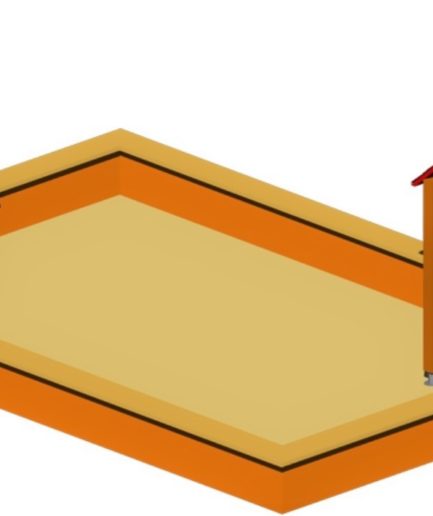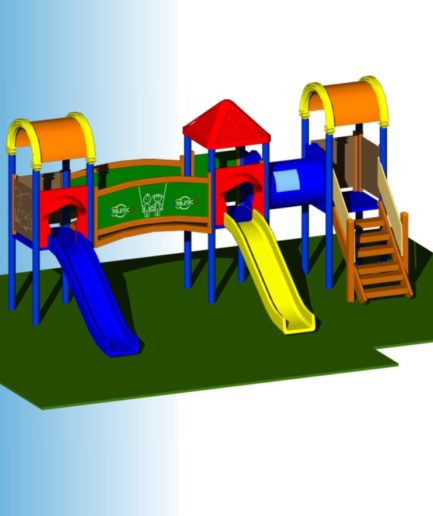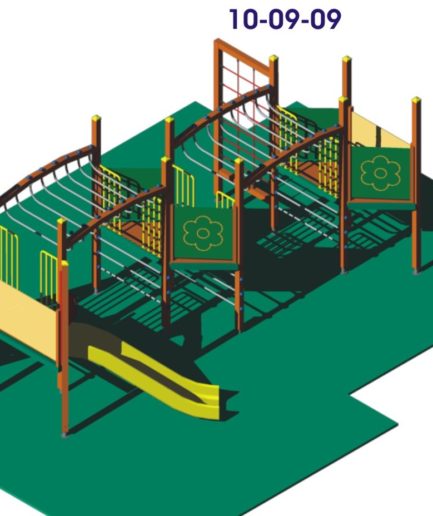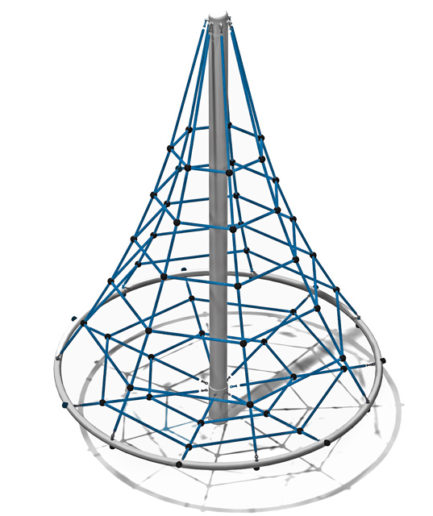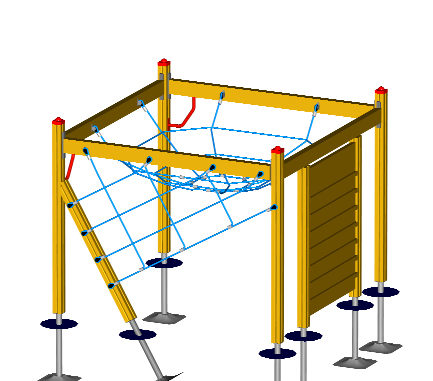TECHNICAL DESCRIPTION
THREE POSITIONS METAL SPRING SAW
MOD 10-10-01
The instrument consists of three (3) horizontal metal beams 2 ” in length and 115 cm long, which are joined exactly in the middle.
For the best stabilization of this connection, a cross-section ‘”P” 80cm long cross-section is mounted on the upper and lower sides of the horizontal beams, which embraces the beams and the sheets are joined by passing screws.
In the cross-section, located at the bottom of the saw, three safety springs Ø 25 mm up and down the spacer are mounted on each side of the cross.
At the bottom of the springs are mounted 1 ½’’ and 50 cm tubes, which are joined together and fastened to the ground with cement.
Four (4) triangular platforms are mounted on the joining beams to prevent users from accessing the springs. These platforms are of 40x20x4.5cm timber.
At the four edges of the beams, 18 mm thick HDPE (High Density Polyethylene) sections have been fitted in animal form. These shapes are fitted to the beam with the help of 3 / 8X11 screws.
The handles – pedals made of metal pipe “Ø ½” and “P” shaped are fitted on the forms. Also at the edges of the beams are the seats of the saw, also made of 18 mm thick plywood, coated with a special durable tire.
TIMBER
The wood used for its equipment is composite non-stick Swedish pine timber, in accordance with EN 351. It is manufactured with special compound (welding of wood) in different sections depending on the intended use.
COMPOSITE wood is 40% stronger than whole wood. It has a strength of 360 kp / m2 and a specific weight of about 480 kg / m3.
It contains about 15% moisture.
It contains minimal juices (resin) compared to other pine family trees in other countries (weather in northern Sweden up to -25 ° C).
It has a thermal conductivity of s = 0.10 Kcal / Mho and sound insulation 3.5 times greater than concrete or bricks of equal thickness.
It has antimagnetic properties and is a poor conductor of electricity.
It is resistant to fire and is classified in categories F30 and F60 (by DIN 4120) according to its cross-section.
When the outer part of the cross-section burns, its interior protects and retains its durability.
It is processed just like commercial wood.
It retains its shape and distorts or creates minimal fractures
Annual wood rings are usually perpendicular to the long side of the cross-section with a significant increase in the mechanical strength of this surface when applied to floors.
All corners of the wood are planed with a radius of about 5 mm.
HDPE PANEL
High density polyethylene panels (HDPE panels) are 19mm thick (sandwich), which not only allows, but also emphasizes the effect of engraving images and shapes on their surface.
They are manufactured by the method of rotary extraction into molds. They are made of linear high density polyethylene and with the addition of materials that provide protection from UV radiation and against static electricity.
Each color, which is non-toxic, is applied by rotary extraction of the mold.
These materials are disciplined by:
ASTM – D – 790: 00 (Flex Modulus – Flexible elements)
ASTM – D – 638: 01 (Tensile Strength – Tensile Strength)
ASTM-D – 648: 01 (Heat Distortion Temperature – Heated Distortion)
ASTM – D – 792: 00 (Density)
ASTM – D – 256: 00 (Impact strength – Impact strength)
ASTM – D – 2240: 02 (Hardness – Hardness)
ASTM – D – 1525: 00 (Softening Temperature – Degrading Temperature)
ASTM – D – 570: 98 (Water absorption)
MS ISO 11357-3: 03 (Melting Point – Melting Temperature)
ASTM = the American Society for Testing and Materials, the American Materials Testing and Testing Service.
PLASTIC COMPONENTS
The plastic components required to manufacture the equipment are highly resistant to UV radiation and adverse weather conditions. Preferred are recyclable materials such as polyethylene (PE) or polypropylene (PP). Specifically all screws protruding from the equipment over 5 mm are covered with polypropylene (PP) plastic plugs. They are also safe for the safety and health of children.
METALLIC ELEMENTS
The metallic elements used in the manufacture of the equipment (screws, connectors, etc.) are made of metals either thermo-galvanized or electro-galvanized, where the surface preparation has been preceded by sandblasting or stainless steel. The dimensions and cross-sections of the metallic elements are sufficient to receive (with an appropriate safety factor) the loads for which they have been designed to withstand corrosion and adverse weather conditions.
PAINTS
The varnishes and the colors that protect the wooden parts are specially designed for the climate of our country (temperature changes, open or closed areas etc.) are absolutely harmless to the users (they do not contain lead, chromium, cadmium and other heavy metals). ) and give great durability to our constructions.
PACKING
The following procedure is used for fixing the equipment:
At this point where the column is to be installed, a 60 cm deep pit is opened. about 50cm in diameter. Then, once the column is inserted, the pit is filled with frusto-concreted concrete until it reaches 10 cm. from the ground surface, where it is covered with soil.
The ground holds only the metal standings that hold each pillar at a height of about 10 cm from the ground in order to prevent the wood from being eroded by soil moisture.
All production work processes for the processing of raw materials are carried out according to:
EN 1176 Standards 1-6
The ISO 9001: 2015 quality system
The ISO 14001: 2015 Environmental Management System


